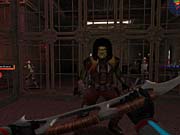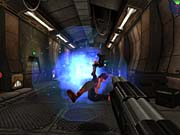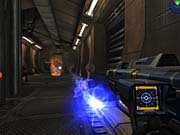Star Trek Elite Force II Hands-On Preview
We take a hands-on look at Activision's Star Trek first-person shooter.
Fan interest in a television series can long outlive its run on the networks, and licensed games can provide some solace for bereaved fans. Considering the less-than-impressive box-office performance of Star Trek: Nemesis, it doesn't seem certain that the full crew of The Next Generation will make another movie appearance, but it's probably safe to expect Star Trek games to keep going strong. Activision's upcoming Star Trek Elite Force II follows up on the final episode of Star Trek: Voyager and features events that take place after the lost ship makes its way back to Earth. You'll reprise your role as Lt. Munro, the leader of an elite away team called the "hazard team" that Captain Picard reforms on the Enterprise to deal with risky missions. From what we've played of an early version of the game, Elite Force II clearly attempts to reproduce the look and feel of actual Star Trek episodes in its first-person action missions.

As often as the Enterprise gets into major galactic adventures, the crew can't always be on duty. One of the most unusual elements of Elite Force II is that you can freely wander around parts of the Enterprise-E between missions. As soon as Munro beams aboard the ship and gets a quick orientation from Picard and Tuvok, you'll be free to explore two separate decks. Before being called to the bridge and getting involved in the next mission, you'll engage in a holodeck training program, talk to a few key hazard team members, and overhear conversations relating personal details about the crew. This element of the game doesn't seem to be very deep or provide all that many activities, but running around the bridge, engineering, and sick bay should provide a few moments of entertainment for those who've wondered what the locations might look like up close.
Soon enough, your team will be sent to investigate the origins of a distress call from the USS Dallas. By the time the transporter leaves you in Dallas' dark shuttle bay, the ship is derelict, without power or artificial gravity. The ensuing sequence is more reminiscent of a Star Trek episode than a typical first-person shooter level, as you'll have to explore the ship's maintenance tunnels, use your tricorder to interface with the power and gravity systems, and solve a series of simple puzzles to restore the systems. The power puzzle is one of several types that recur throughout the game. One involves rotating pipes drawn on a square grid. You must reestablish connection of the matching colors and avoid interference from other power sources. At their best, the game's minigame puzzles seem to require you to think through challenges in urgent circumstances, which is entirely appropriate for the Star Trek setting.

In one level, you'll catch brief glimpses of scurrying alien shapes, which means that you'll be in for some real action soon. The pace actually picks up quickly once you solve several puzzles. Apparently, the USS Dallas has fallen victim to creatures called exomorphs, which a crew member helpfully points out must have been genetically engineered because they have jetpacks built right into their carapaces. The exomorphs play a central role in a story that has more than a few plot twists in store, and these small, clawed creatures hint at much bigger, nastier things to come. Waves of exomorphs can appear from behind in close quarters or swarm you in larger area, and they pose a real threat to you, even when you're armed with the fast-firing phaser rifle or the Federation's new phaser shotgun. Other hazard team members often have to be left to specific tasks, so you'll spend long stretches fighting it out on your own.
He's Dead, Jim

Discovering the fate of the USS Dallas leads Picard to retrace part of the ship's last voyage--and this reveals that Enterprise itself will soon be in grave danger. The result is that you'll be up against humanoid enemies after a few missions. While some of the game's humanoid aliens might not look as menacing as the exomorphs, they are smarter about taking cover and often come armed with devastating ranged weapons. One group of enemies is tricky about hiding behind energy shields, and things will really heat up when you take on a space station full of mercenaries single-handedly.
The game's 11 missions are broken up into three to seven sublevels each, and a number of levels in the missions we played concluded with fights, either defending a VIP or attacking a powerful boss. Much of the game's action sequences have a fast-paced, run-and-gun quality, which may not be surprising, considering that the game is powered by the Quake III engine, physics and all. The developer has also seen fit to add a certain amount of replay value to the otherwise linear levels by including secret areas and hidden starship icons--collect enough icons, and you'll be able to unlock a few extra maps. The tricorder's secondary function, a structural integrity view, plays a part in the hunt for secret areas and in some of the main puzzles. With this orange-tinted view turned on, weak points in doors and walls are shown in bright red, and these points can be easily blasted apart with a phaser. The other view option is night vision, which you can turn on at any time to help you find your way around the USS Dallas' darkened corridors.
Elite Force II's visuals prove that a game can still be based on the Quake III engine and look good. The screenshots provide a good indication of how detailed the textures are in both the environments and the character models. The textures for the Enterprise's electronic displays are sharp enough that you can usually read everything, down to the small static numbers at the bridge's ship controls. In-engine cutscenes help convey the story and exhibit solid production values, especially in the game's voice acting, which was provided by the actors who play Jean-Luc Picard, Tuvok, and Barclay in the Star Trek show and movies.

Much like the previous Elite Force game, Elite Force II comes complete with a variety of multiplayer features that essentially convert Quake III to the Star Trek setting. There are four modes in the beta version we played: deathmatch, team deathmatch, capture the flag, and bomb diffusion. Except for a name change that has deathmatch appear as "holomatch," the first three modes are no different than those in id Software's original 1999 shooter. Bomb diffusion is a team game that involves picking up a bomb in the middle of a symmetrical map and taking it to the opponent's base to detonate it. All modes support AI bots for solo, local network, or online play.
Elite Force II incorporates a few new gameplay elements that provide alternatives to simply running around and shooting, as well as a few elements that help give the game an authentic Star Trek look and feel. The game is scheduled for release in late June.
Got a news tip or want to contact us directly? Email news@gamespot.com
Join the conversation